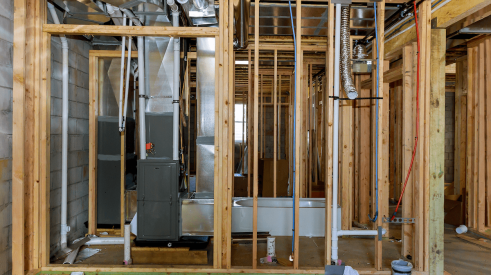If you want to spark a debate that can flare passions or even tempers, try asking a group of builders, “Do customers really care about green housing?” The response ranges from “absolutely not” to “of course they do” to “yes, as long as it doesn’t cost them one dime.”
Everyone has their evidence, sources, and surveys, so much that whichever argument you last heard sounds like the correct one. The question grows more complicated when we consider the cost of compliance with numerous state, federal, and independent ratings and certifications such as Energy Star, NAHB Green, and LEED. Now break these down into the many levels that can be achieved, such as gold, silver, and bronze, and ask if home buyers value these ratings. Finally, toss in the financial incentives that may be available to the customer and the builder from state and federal agencies and utility companies. If you feel a headache coming on, you’re in good company, and unfortunately we can’t sort that all out in this article. We can all agree, however, that the primary concern for most builders is the cost of green, and that’s no surprise. Few are willing or able to absorb the cost of someone else’s notion of “doing the right thing” in this economy.
Breaking Down the Green Building Cost Equation
There are multiple factors at play in the green building cost equation. Of up front concern to the builder are hard costs. A classic example today is the virtually instant, on-demand, tankless water heater. On the surface, it makes perfect sense. Why would anyone keep a tank of water hot enough to scald someone 24/7? It seems eminently logical to just heat water as you need it. No pilot light, no vacation setting, and no tank to rust out if the homeowner neglects to drain and flush the tank regularly — and everyone forgets. Who wouldn’t pay for that? As it turns out, a lot of people, given that the marginal hard cost between a standard tank and a tankless system ranges from $600 to $1,500 per unit, depending on size and demand. Many feel the payback period is just too long. But wait! There is that federal tax incentive and another from the state — or did that expire already? And the utility company is offering a $250 rebate, but who gets that, the homeowner or the builder? What happens if we go tankless and next year the incentives go away? Maybe this could work out after all — or not.
There is a long litany of these price/benefit trade-offs to consider. The low-E glass will cost more, but it may enable us to drop the A/C unit half a ton. Switch to that new insulated roof sheathing and maybe we drop another half-ton and can downsize the ductwork. Is a single HVAC system with remote zones and a variable-speed blower more efficient and cost effective than two smaller standard systems, one for the first floor and one for the second? And which costs more? Your two contractors are telling you two different things. On that ranch unit, getting the air handler moved from over the garage to a central attic location will save $500 in ductwork, but will customers complain about noise? How about the impact of a raised-wood foundation versus a slab? Or insulating the basement walls? Or foam-sealing electrical outlets, plates, and corners? Do we go with 2x4s at 16 inches on center with foam sheathing for exterior walls or 2x6s at 24 inches on center with OSB sheathing and thicker bats, and which will be perceived better by the customer? LED can lights are still too expensive, aren’t they? But customers are telling us the CFL’s are ugly.
We’re just getting started with the questions but have to leave them midstream because the myriad rules, regulations, equipment, claims and counter-claims, and whims of local housing authorities turn this into a conundrum of the first order. And any time you think you have the formula nailed, remember that regulations, certification requirements, rebates, and tax breaks are all in a constant state of flux. You can’t count on any of it, year to year, and there hasn’t been a really good “magic decoder ring” available since Johnny Quest. Building green — or sustainability if you prefer — has become the building industry’s Rubik’s Cube. Each time you think you are there a piece or two winds up in the wrong place.
Is There Any Element of Green Building That's Predictable, Has an Environmental Benefit, and Saves Money?
Gratefully, there is one, and that is through Lean building process and methods. The simplest definition of Lean is, “The relentless pursuit, identification, and elimination of all forms of waste in product and process.” But in Lean building, waste is more broadly defined than most builders are accustomed. The direct cost-reduction impact of Lean is well documented, as I've previously described. Usually missed, however, is the happy fact that when you reduce waste of any kind, there is often a clear green benefit. Consider the example of the president of a large lumber company entering a meeting with a noted Texas builder whose people were expecting a presentation on how they could better use product. He walked up to the flipchart and wrote in large print, “37,512,” underlined it, and challenged the builder team to identify what the number represented. They suggested dollars, days, man-hours, board feet of lumber, and miles, among many other guesses, until they gave up. The answer was diesel fuel, more specifically the number of gallons of diesel fuel he had determined was spent annually on wasted, extra, or otherwise unnecessary trips to building sites.
Right off the top, at the $3.07 national average diesel price as of late October, that represents a direct cost of over $115,000. It also means 1,000 additional fueling stops, four each working day, to refuel, requiring at least 350 man-hours. The additional 150,000 miles driven (at four mpg) represents tires, oil, service, depreciation, risk exposure, and extra insurance premiums. Plus, there are the costs of loading and unloading, and perhaps the biggest of all, opportunity cost. When that truck and driver are making an extra trip and the yard crew handles the material again and again, they’re making zero profit for the supplier. All in, you can conservatively double that $115,000 cost to something over $230,000. That number should get any builder’s attention, and it does, once it’s identified and costed in a Lean review process. But what about the green aspects?
Obviously, not having to drill for, pump, transport, refine, transport again, store, and transport yet again any diesel fuel saved is a green contribution. There is tremendous power used in drilling and also a lot to clean up. Diesel is also high in particulates and carbon emissions, so eliminating 37,512 gallons is a significant reduction. A quick Google search reveals it takes 4.67 gallons of crude to extract 1 gallon of diesel fuel. Do the math and you’ll find that this single supplier for a single builder in a single city required nearly 4,200 barrels of crude. Another trip to Google divulges that it takes fewer than 500 suppliers wasting this much diesel to drain your average 2 million barrel supertanker arriving from the Middle East. Consider that for a moment. That was a big supplier for a big builder, but how many suppliers and trades wasting substantial fuel in each of our top-100 building markets are there? 50? 100? So simple wasted trips in our industry might represent five, 10, or perhaps more supertankers full of oil. At the current price of around $80 a barrel, that means a billion or more dollars going overseas.
This case is one where Lean is green — and it’s better than free. And if any builders are sticking with the notion that if they save their suppliers and trades substantial dollars that it will not pay back to them, they have substantial remedial learning to do in Lean operations.
Look at Foundations, Roofing, and More
Similar numbers are turned up when a builder, along with the supplier, trade, architect, and especially the engineer, take a critical look at foundations. Multiple case histories document savings of 3 to 10 and occasionally more yards of concrete. The waste may be found in the elimination of unnecessary corners, the prevention of “boil out” under forms, properly sizing all footers, walls, and slabs, and getting the mix right. One builder in Texas was able to eliminate 700 concrete loads per year, saving more than $60,000 in direct cost. Similar to the example above on diesel fuel, the production of concrete requires tremendous power, beginning with the mining of gravel and cement, transportation, blending, more transportation to the site, and, in many cases, pumping. Reduce concrete waste and you benefit both the environment and your bottom line.
There are innumerable similar examples, such as roofing material savings — 80 percent of which is petroleum-based in the U.S. — and reducing framing lumber, which gets into the touchy subject of forest preservation. The most obvious, however, is waste haulage from the building site. The NAHB Research Center estimates the average cost per unit of waste is $1,200, representing multiple “pulls” of dumpsters for each house.
There is much that can be done to be more efficient on the back end, but even more effective is good design and building process. Lean techniques, such as even-dimension analysis, reduce cut-off scrap and trimmings from framing lumber, sheathing, carpet, and a host of other components. Matching available drywall to room dimensions and vice versa has been shown to save as much as $1,250 in a 2,200 square foot home and greatly reduce scrap. Simply ensuring that drywallers hang closets and smaller spaces last can have a huge impact. The key is not getting excess waste to the site in the first place, which is one of the major benefits of factory-built trusses, panels, and SIPs. Then, once the material is on site, using it to the utmost efficiency. You know you are getting there when the framers start complaining that they can’t find enough scrap for blocking for drywall, cabinets, or stair rails.
An additional area of payoff is found on the administrative side. The most progressive builders have gone totally digital, including POs, VPOs, plans, specifications, bid packages, scopes, contracts, change orders, schedules, payroll, electronic banking, and wire transfers. The savings in printing, postage, paper, power, and petroleum are substantial, including the elimination of countless trips saved by contractors to the office to pick up any number of documents. Don’t overlook this aspect of waste elimination, which has significant green impact.
So much of our green focus is on the more sensationalistic aspects of high-tech materials, but few are ready to build homes that sell power back to the utility grid or recycle gray or even black water back to the kitchen sink. Builders should continue to explore the edges of the green envelope. Meanwhile, tremendous impact can be made on both the bottom line and the environment through the application of Lean methodology to daily operations. Remember, Lean is green — and it’s free.
7 Ways to Go Green Using Lean Principles
1. Smart design. A big part of resource efficiency is designing plans to match the dimensions by which products are available. Optimize plans with respect to lumber and sheathing sizes, drywall, carpet, and HVAC, among other components. The result is lower up-front purchase cost and less scrap or excess removal from the site.
2. Improved schedule. This reduces costly trips and fuel usage.
3. Lean construction methods. There are hundreds of examples, from reducing concrete “boil out” under form footers, walls, and slabs, to getting material staged on the site to reduce damage, to protecting driveway corners with discarded conveyor mats from quarries. Each one reduces fuel and waste.
4. Advanced framing techniques. Significant material reduction means cost reduction in both up-front purchases and waste removal. For example, properly sizing and, in many cases, eliminating unnecessary interior headers can save hundreds per house. The environmental impact is reduced from the forest to the mill to the building site to the landfill.
5. Waste reduction/reuse/recycling. When waste is watched and highlighted, we waste much less. One less dumpster pull per house can save as much as $400, and the green benefit is obvious. There are builders successfully sorting trash by type and dealing with it as appropriate. Cardboard and metals are recycled. Waste wood becomes mulch. Drywall becomes a soil amendment.
6. Everything electronic. POs, VPOs, plans, specifications, bid packages, scopes contracts, change orders, schedules, electronic banking, wire transfer, etc. You save paper, ink, postage, courier fees, plus hundreds of trips between site and offices for builder personnel, suppliers, and trades, alike.
7. Education. Builders, suppliers, trades, and consumers are largely unaware of the green implications of building Lean. Education is required.
Advertisement
Related Stories
Sustainability
Which Green Building Practices Are Home Builders Using Most?
A recent report reveals which green-building practices are most popular among single-family home builders and remodelers
Sustainability
Study Shows More Home Builders Adopting Green Building Practices, Products
A new study finds a marked increase in the number of home builders embracing eco-conscious, sustainable practices and products
Codes + Standards
Public Comment Period Opens for 2024 National Green Building Standard Update
The 45-day public comment period opened Aug. 18, and comments must be submitted by Oct. 2, 2023








